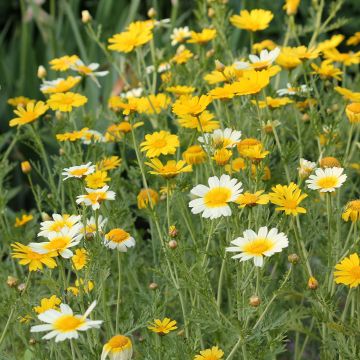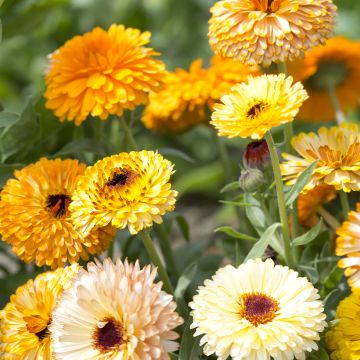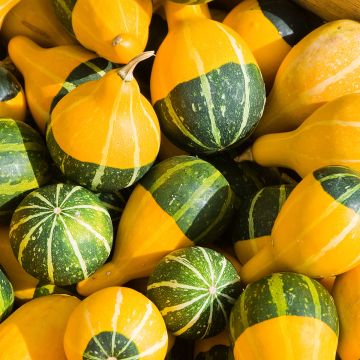

Tanacetum parthenium Tetra White Wonder Seeds - Feverfew
Tanacetum parthenium Tetra White Wonder Seeds - Feverfew
Tanacetum parthenium Tetra White Wonder
Feverfew
Special offer!
Receive a €20 voucher for any order over €90 (excluding delivery costs, credit notes, and plastic-free options)!
1- Add your favorite plants to your cart.
2- Once you have reached €90, confirm your order (you can even choose the delivery date!).
3- As soon as your order is shipped, you will receive an email containing your voucher code, valid for 3 months (90 days).
Your voucher is unique and can only be used once, for any order with a minimum value of €20, excluding delivery costs.
Can be combined with other current offers, non-divisible and non-refundable.
Home or relay delivery (depending on size and destination)
Schedule delivery date,
and select date in basket
This plant carries a 6 months recovery warranty
More information
We guarantee the quality of our plants for a full growing cycle, and will replace at our expense any plant that fails to recover under normal climatic and planting conditions.
Would this plant suit my garden?
Set up your Plantfit profile →
Description
The 'Tetra White Wonder' Feverfew, known as Tanacetum parthenium in Latin, is also called Chrysanthemum parthenium. It is a hardy perennial plant that produces small, double white flowers resembling pompoms, with a small green centre. They are fragrant and bloom profusely from June to September. The plant self-seeds so abundantly that its short lifespan may not be immediately noticeable.
The species Tanacetum parthenium, also known as Feverfew, belongs to the asteraceae family. Native to Eastern and Southern Europe and temperate Asia, it has been widely naturalised elsewhere. Feverfew is cultivated for both medicinal and ornamental purposes. It is a herbaceous perennial plant that grows 30 to 70 cm tall, with an upright, almost smooth, highly branched and leafy stem. The leaves have petioles, are hairless and aromatic, and resemble those of a chrysanthemum. Feverfew can be distinguished from the other two medicinal chamomiles by its greater height and wider leaf lobes.
The 'Tetra White Wonder' Feverfew reaches a height of 70 cm in one season, with a width of 30 to 40 cm. It produces highly double pompom-like, fragrant, white flowers with a greenish centre. It blooms profusely throughout the summer.
This 'Tetra White Wonder' Feverfew, with its chrysanthemum-like appearance, is robust and reliable in the garden due to its abundant self-seeding. It is very easy to grow and can thrive in ordinary soil while preferring a sunny exposure. It is a bushy plant that easily integrates into a perennial flower bed. When paired, for example, with roses or hardy geraniums, its simplicity allows it to complement any style of flower bed and plants. When sown in a pot, it provides a long-lasting solution for decorating terraces and balconies. With excellent vase life, it will allow you to create beautiful countryside bouquets throughout the summer.
Report an error about the product description
Flowering
Foliage
Plant habit
Botanical data
Tanacetum
parthenium
Tetra White Wonder
Asteraceae
Feverfew
Chrysanthemum parthenium, Chrysanthemum praealtum, Leucanthemum parthenium, Matricaria parthenium, Matricaria eximia
Cultivar or hybrid
Other Chrysanthemum seeds
View all →Planting and care
Sow Tanacetum parthenium in a tray 6 to 8 weeks before planting in the garden, after the last frost. Use good quality potting soil. Sow your seeds by broadcasting. Cover the seeds by sprinkling soil or vermiculite on top, lightly press down and water thoroughly with a fine mist. Place your tray in a well-lit area, without direct sunlight, at a temperature of 15°C to 20°C. Reduce the temperature slightly at night.
Growth is fast. Once the seedlings reach a height of 5 cm, transplant them into pots. 15 days before their final planting, start gradually acclimatising them to outdoor temperatures.
By the end of May, the temperature in the garden will be warm enough to plant your young plants. Choose a sunny location. Space your plants 30 to 40 cm apart.
To promote a more branched growth, pinch the tops of the stems 2 to 4 times during cultivation.
Remove faded flowers to promote the quality of flowering.
You can also sow directly in place after the last frost.
Sowing period
Intended location
This item has not been reviewed yet - be the first to leave a review about it.
Similar products
Haven't found what you were looking for?
Hardiness is the lowest winter temperature a plant can endure without suffering serious damage or even dying. However, hardiness is affected by location (a sheltered area, such as a patio), protection (winter cover) and soil type (hardiness is improved by well-drained soil).

Photo Sharing Terms & Conditions
In order to encourage gardeners to interact and share their experiences, Promesse de fleurs offers various media enabling content to be uploaded onto its Site - in particular via the ‘Photo sharing’ module.
The User agrees to refrain from:
- Posting any content that is illegal, prejudicial, insulting, racist, inciteful to hatred, revisionist, contrary to public decency, that infringes on privacy or on the privacy rights of third parties, in particular the publicity rights of persons and goods, intellectual property rights, or the right to privacy.
- Submitting content on behalf of a third party;
- Impersonate the identity of a third party and/or publish any personal information about a third party;
In general, the User undertakes to refrain from any unethical behaviour.
All Content (in particular text, comments, files, images, photos, videos, creative works, etc.), which may be subject to property or intellectual property rights, image or other private rights, shall remain the property of the User, subject to the limited rights granted by the terms of the licence granted by Promesse de fleurs as stated below. Users are at liberty to publish or not to publish such Content on the Site, notably via the ‘Photo Sharing’ facility, and accept that this Content shall be made public and freely accessible, notably on the Internet.
Users further acknowledge, undertake to have ,and guarantee that they hold all necessary rights and permissions to publish such material on the Site, in particular with regard to the legislation in force pertaining to any privacy, property, intellectual property, image, or contractual rights, or rights of any other nature. By publishing such Content on the Site, Users acknowledge accepting full liability as publishers of the Content within the meaning of the law, and grant Promesse de fleurs, free of charge, an inclusive, worldwide licence for the said Content for the entire duration of its publication, including all reproduction, representation, up/downloading, displaying, performing, transmission, and storage rights.
Users also grant permission for their name to be linked to the Content and accept that this link may not always be made available.
By engaging in posting material, Users consent to their Content becoming automatically accessible on the Internet, in particular on other sites and/or blogs and/or web pages of the Promesse de fleurs site, including in particular social pages and the Promesse de fleurs catalogue.
Users may secure the removal of entrusted content free of charge by issuing a simple request via our contact form.
The flowering period indicated on our website applies to countries and regions located in USDA zone 8 (France, the United Kingdom, Ireland, the Netherlands, etc.)
It will vary according to where you live:
- In zones 9 to 10 (Italy, Spain, Greece, etc.), flowering will occur about 2 to 4 weeks earlier.
- In zones 6 to 7 (Germany, Poland, Slovenia, and lower mountainous regions), flowering will be delayed by 2 to 3 weeks.
- In zone 5 (Central Europe, Scandinavia), blooming will be delayed by 3 to 5 weeks.
In temperate climates, pruning of spring-flowering shrubs (forsythia, spireas, etc.) should be done just after flowering.
Pruning of summer-flowering shrubs (Indian Lilac, Perovskia, etc.) can be done in winter or spring.
In cold regions as well as with frost-sensitive plants, avoid pruning too early when severe frosts may still occur.
The planting period indicated on our website applies to countries and regions located in USDA zone 8 (France, United Kingdom, Ireland, Netherlands).
It will vary according to where you live:
- In Mediterranean zones (Marseille, Madrid, Milan, etc.), autumn and winter are the best planting periods.
- In continental zones (Strasbourg, Munich, Vienna, etc.), delay planting by 2 to 3 weeks in spring and bring it forward by 2 to 4 weeks in autumn.
- In mountainous regions (the Alps, Pyrenees, Carpathians, etc.), it is best to plant in late spring (May-June) or late summer (August-September).
The harvesting period indicated on our website applies to countries and regions in USDA zone 8 (France, England, Ireland, the Netherlands).
In colder areas (Scandinavia, Poland, Austria...) fruit and vegetable harvests are likely to be delayed by 3-4 weeks.
In warmer areas (Italy, Spain, Greece, etc.), harvesting will probably take place earlier, depending on weather conditions.
The sowing periods indicated on our website apply to countries and regions within USDA Zone 8 (France, UK, Ireland, Netherlands).
In colder areas (Scandinavia, Poland, Austria...), delay any outdoor sowing by 3-4 weeks, or sow under glass.
In warmer climes (Italy, Spain, Greece, etc.), bring outdoor sowing forward by a few weeks.



















































